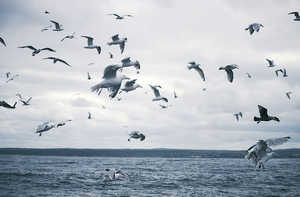Fishing trainera
The spontaneous emergence of the trainera coincided with a
scarcity of salted cod as a result of the Treaty of Utrecht. As a
result, inshore fishermen began to concentrate more on sardines
and other alternatives.
Duhamel du Monceau attributes the invention of both the
encircling net and the swift and easily manoeuvrable trainera
needed to use the nets to an anonymous fisherman from
Hondarribia in the first half of the eighteenth century.
The trainera was a light fast vessel powered by twelve oarsmen
and fitted with a keel with a minimal arched section. This
made it possible to tack or put about very tightly, to cast out
a seine net (called a xerkua) to starboard. This net was designed
to surround the fish, and was relatively small so that it
could be manoeuvred into place quickly.

The term trainera appeared quite late, in the second half of the
nineteenth century; previously these boats had been known by the
more generic names "chalupa" and "lancha Manjuera". © José Lopez

The invention of the encircling net and the trainera were probably
inspired by the chinga and the uarika. The chinga was a net
used in the estuary of the Bidasoa, although it has also been used
in Pasaia. It is thought to be very old and from it comes the place
name Txingudi (the place of chingas), the bay in the Bidasoa
estuary. The technique consisted of casting out the net from the
beach using a vessel about six metres long called a uarika or ubarika,
making a half circle to trap the fish inside. Finally the two ends
of the chinga were hauled in from the beach until the net with its
catch could be recovered. The net was stretched out on the beach
at low tide or mid-tide, generally at dawn, to catch flat-head grey
mullet and to a lesser extent sole and other fish. © José Lopez

The invention of the surrounding net revolutionised the economy
of this region. Catches were increased, leading to growth in the salting industry. This technique met with outstanding success
and it soon spread to the rest of the world. Motorisation of the
boats, making them more powerful, has led to a gradual increase
in the size of the net. © José Lopez

The sails of the traineras were used only for getting from one
place to another, with fishing operations powered exclusively by
oarsmen. © José Lopez

Shoals of sardine could often be located by the flocks of seagulls
and other sea birds flying over them. Watchmen on the coast
would look out for such signs and inform the fishermen.
© José Lopez

Line drawing of a trainera. © José Lopez

Ameriketatik, a replica of a fishing trainera from the second
half of the nineteenth century, based on a plan by Mutiozabal. She
was built by the author in 1998 at the Apprenticeshop boatbuilding
school in Rockland, Maine (USA) and financed by the Basque
Diaspora from the American continent to be presented to the
people of the Basque Country. Since then, Ameriketatik (meaning
“from America”) has represented Basque marine heritage at numerous
international events. © José Lopez

Sardines. © José Lopez












